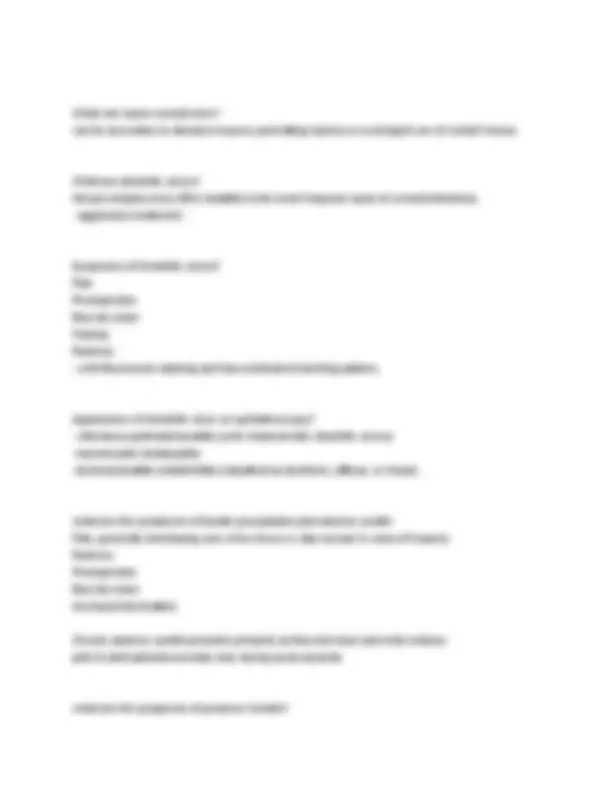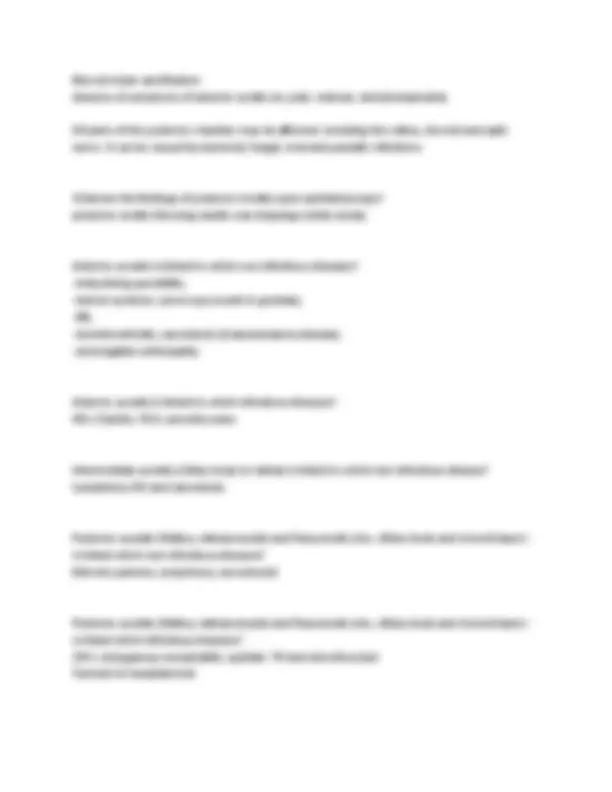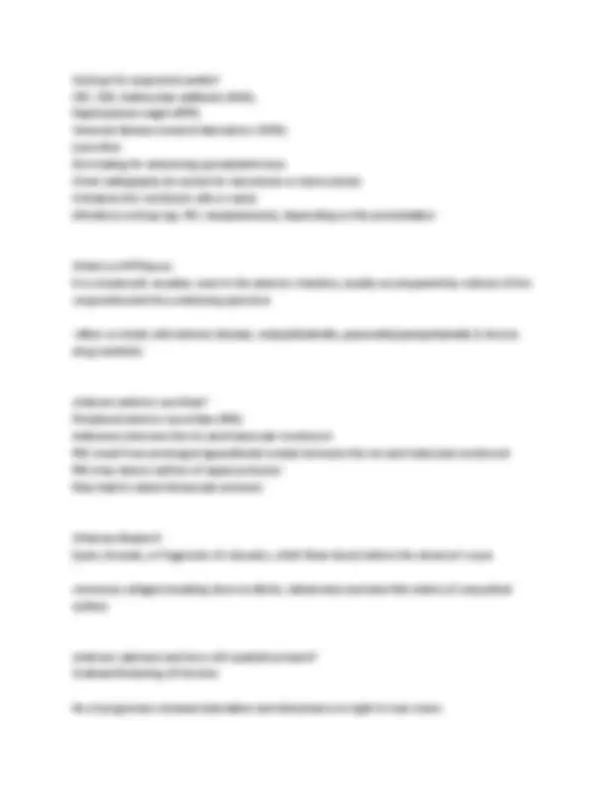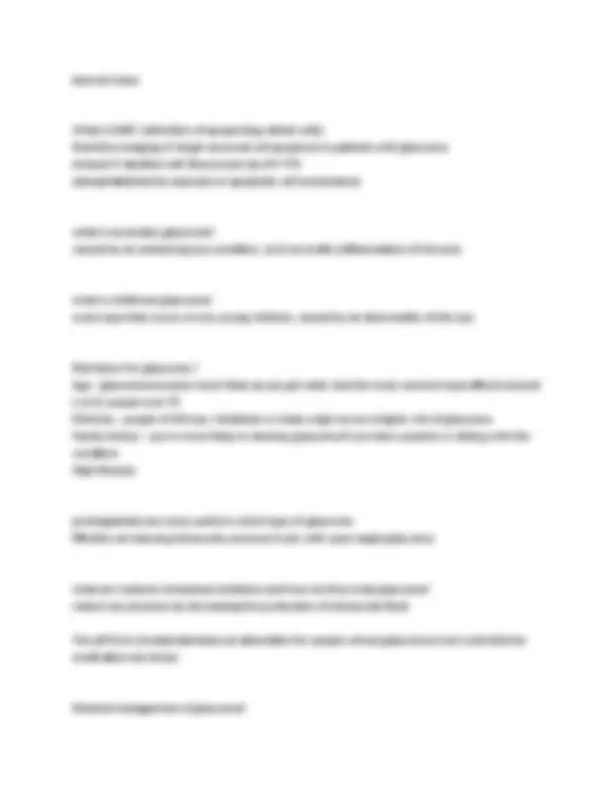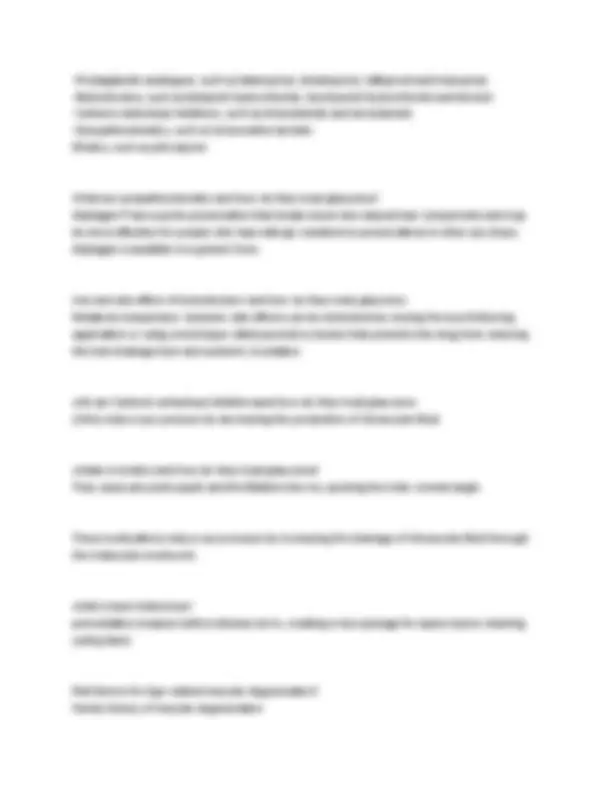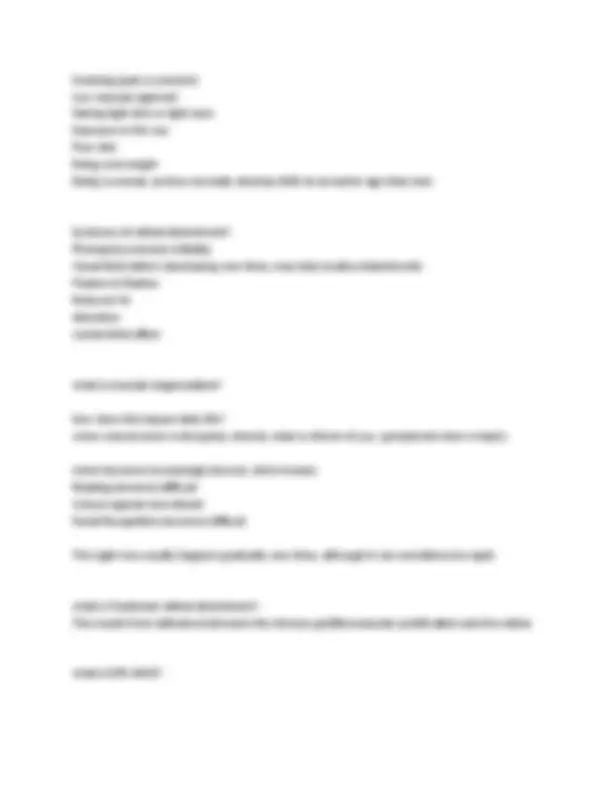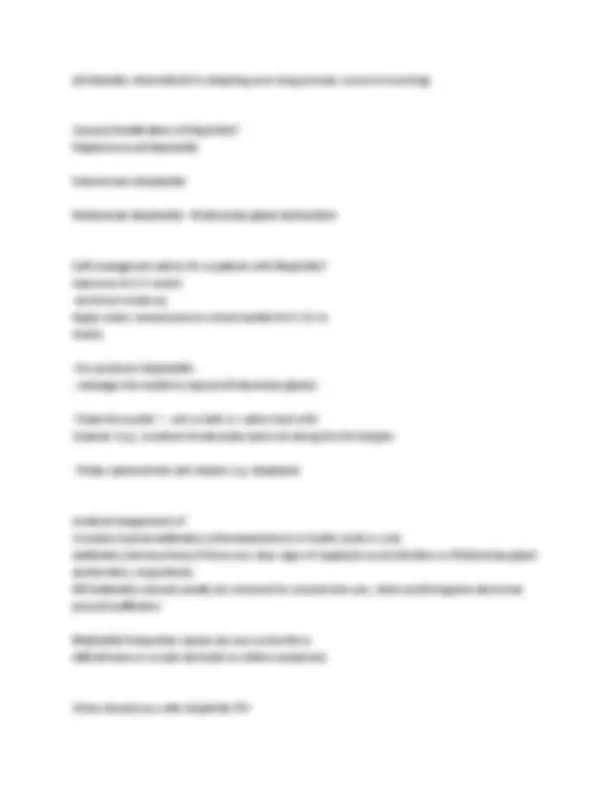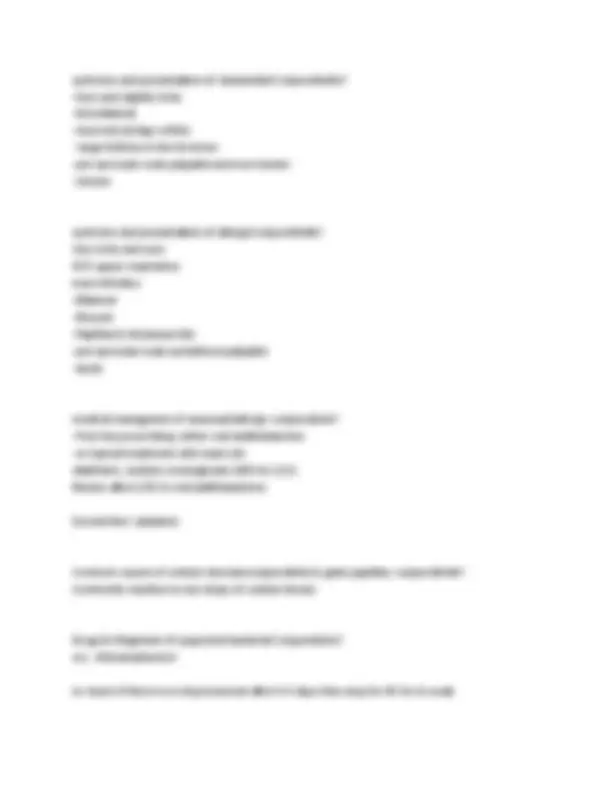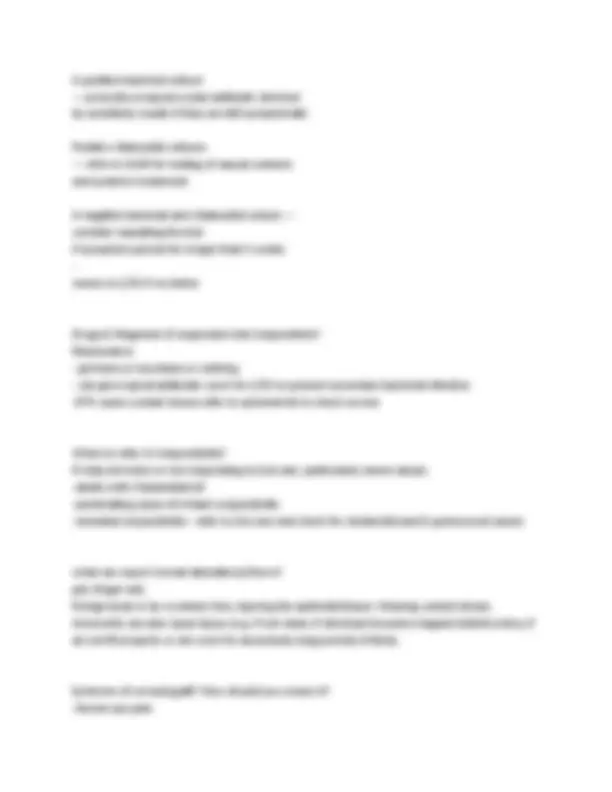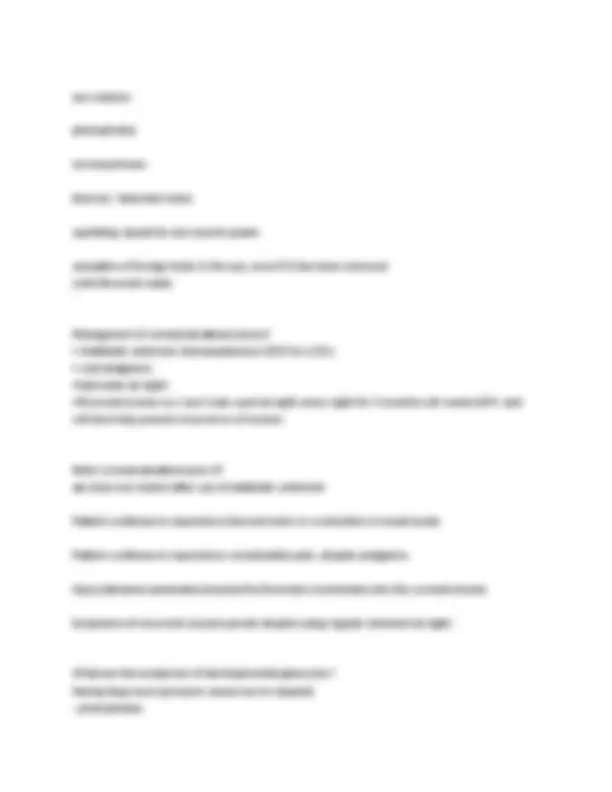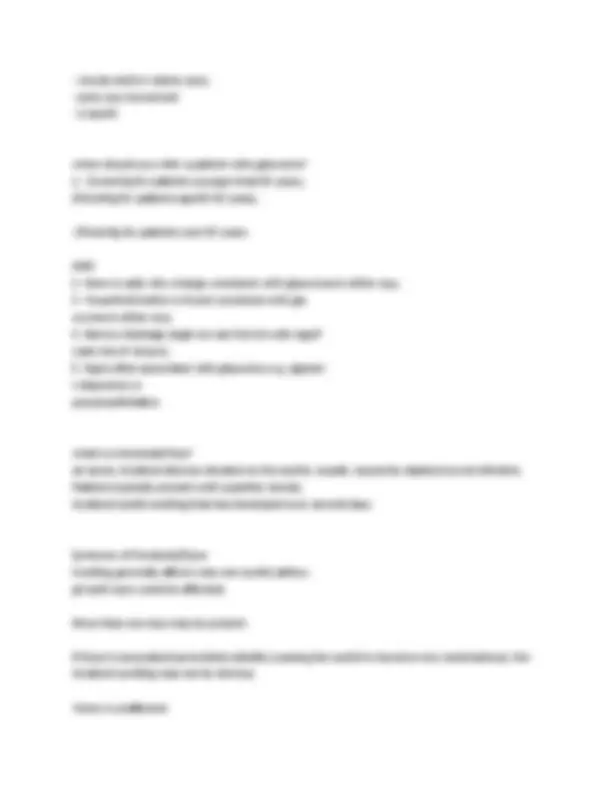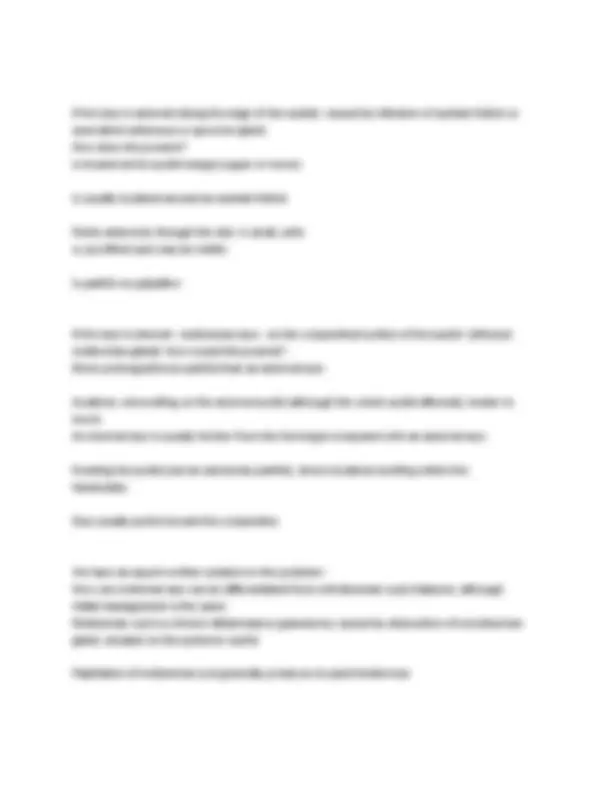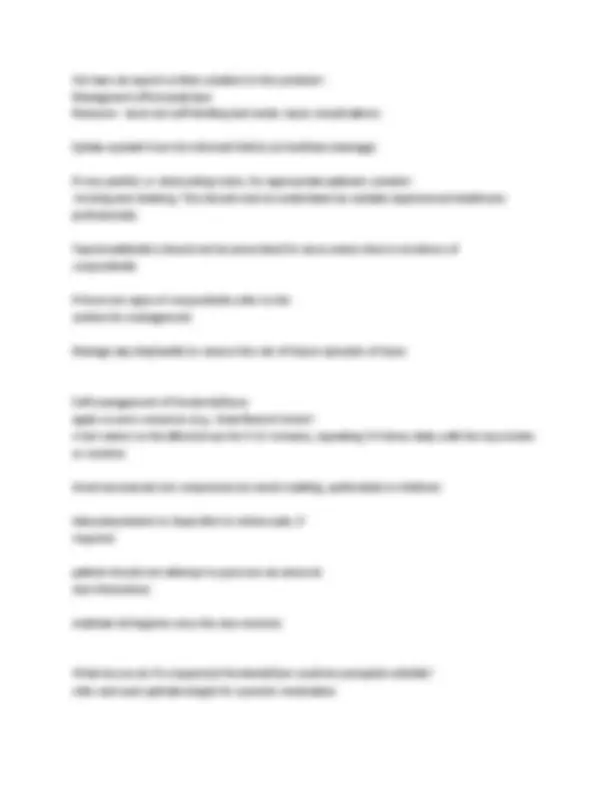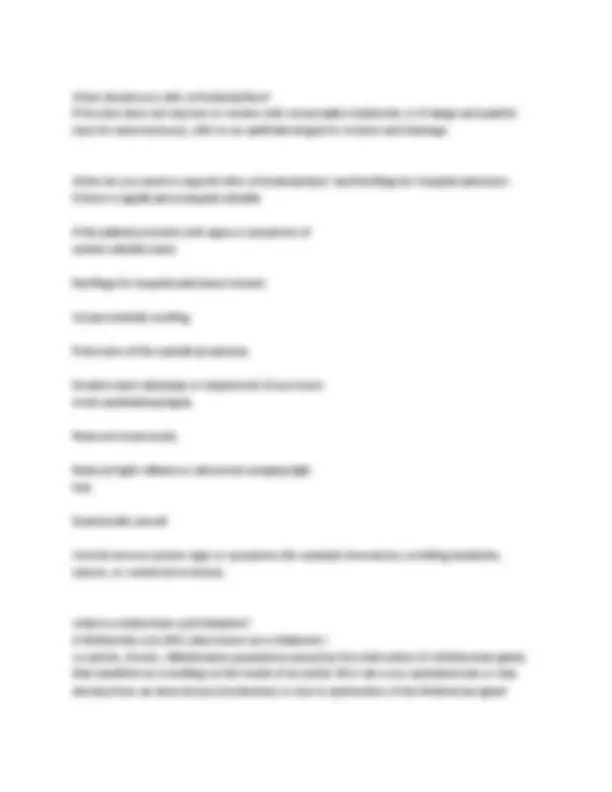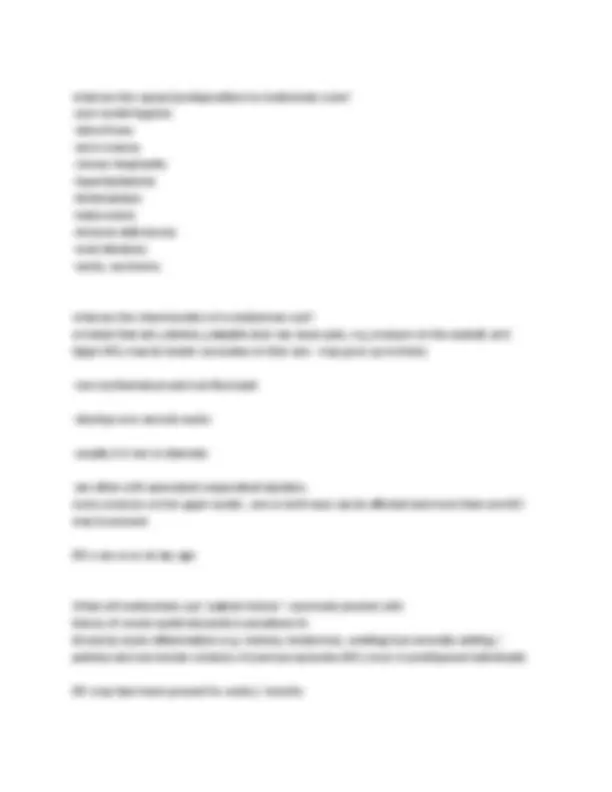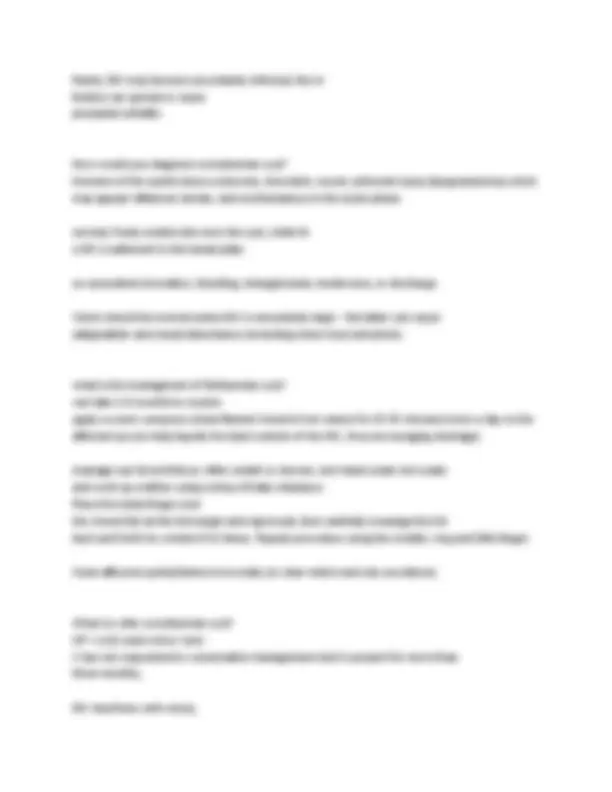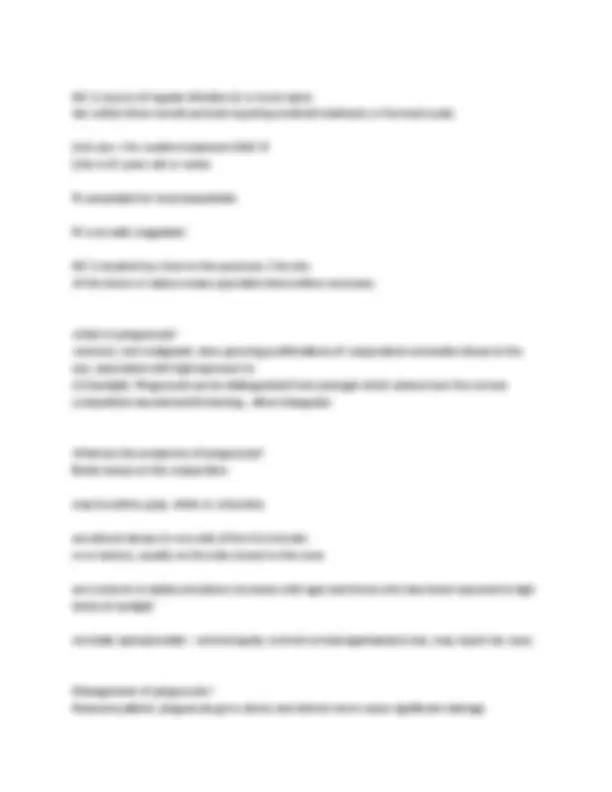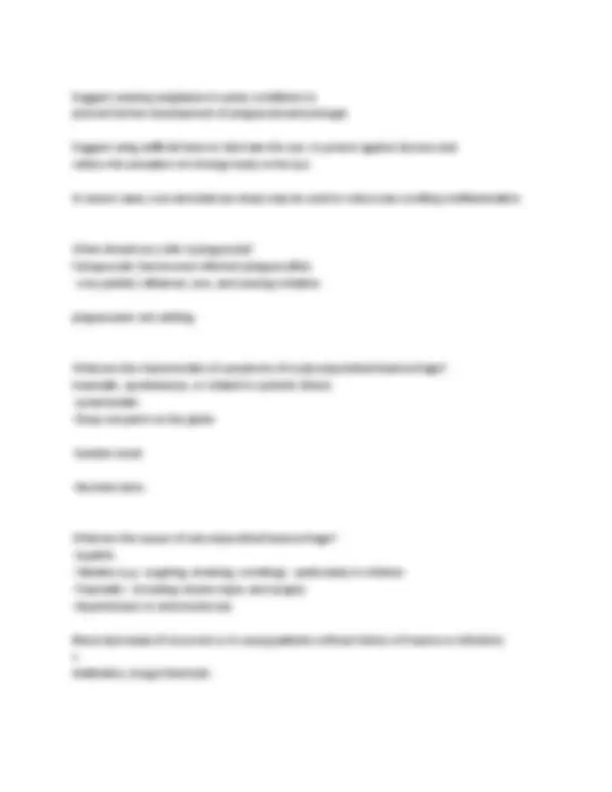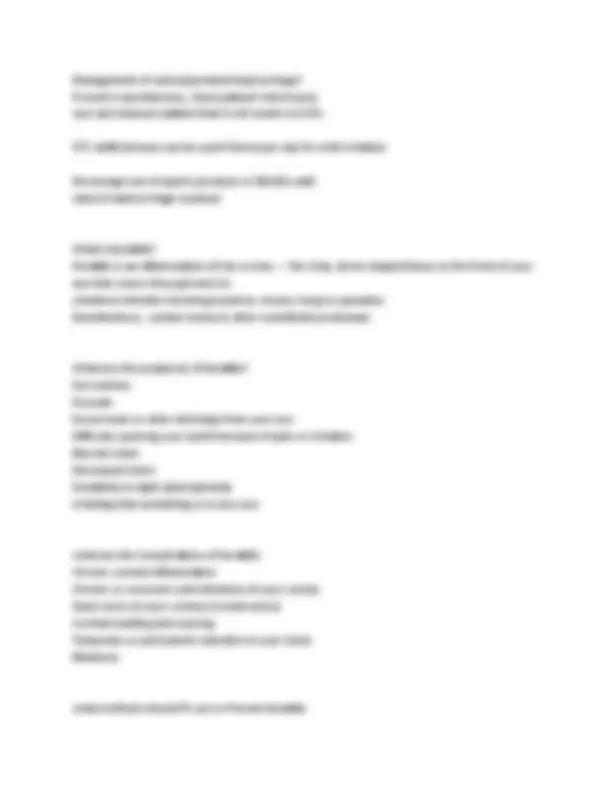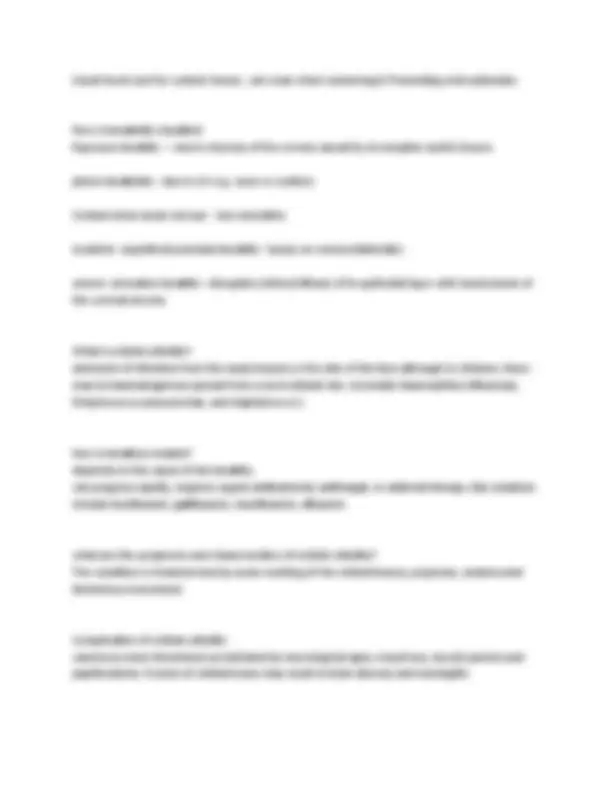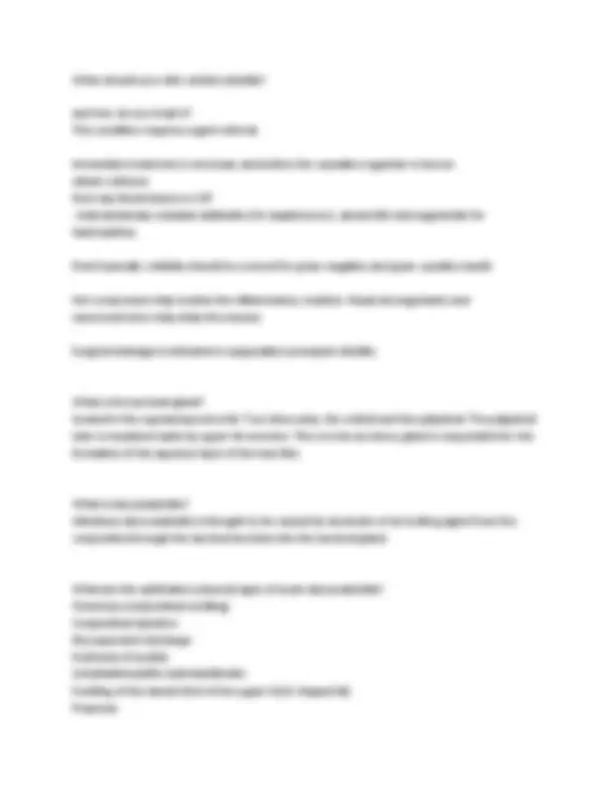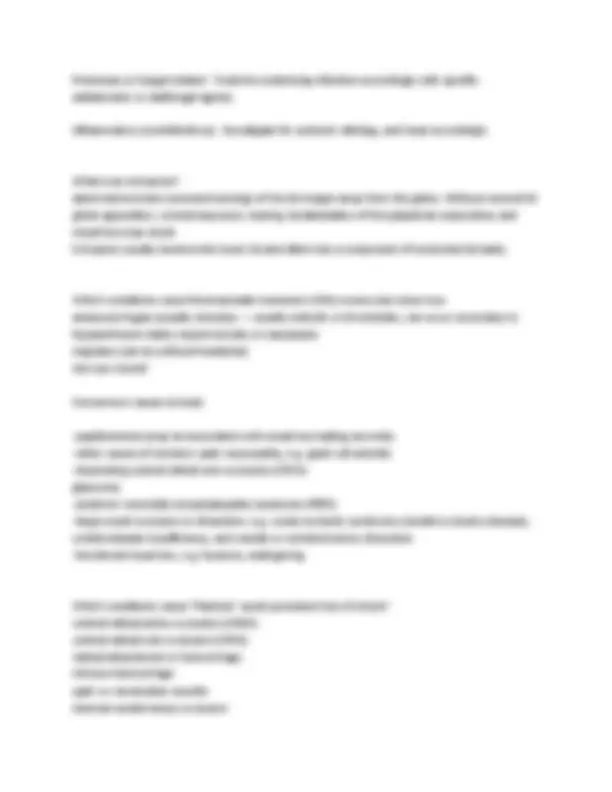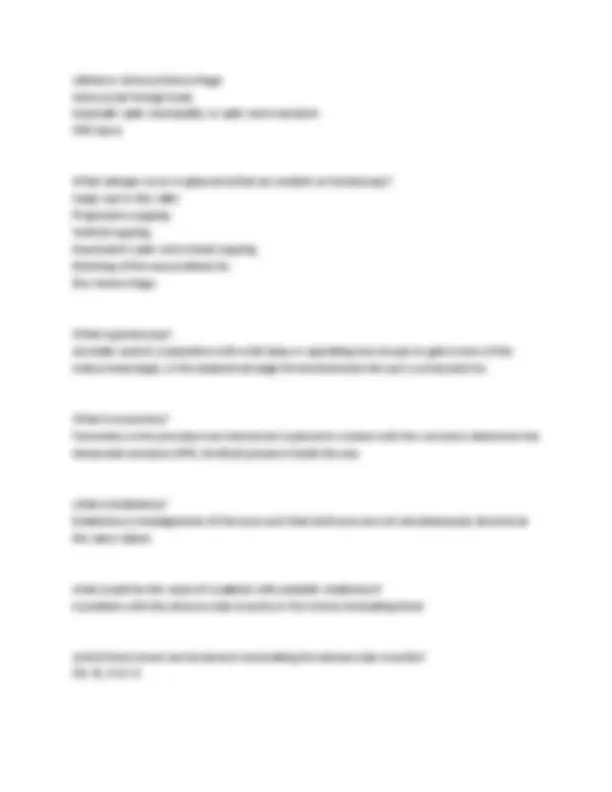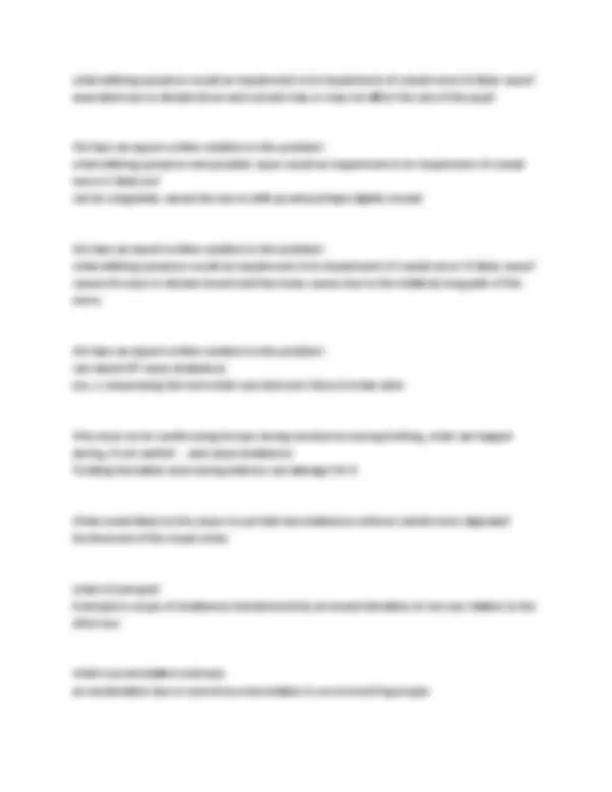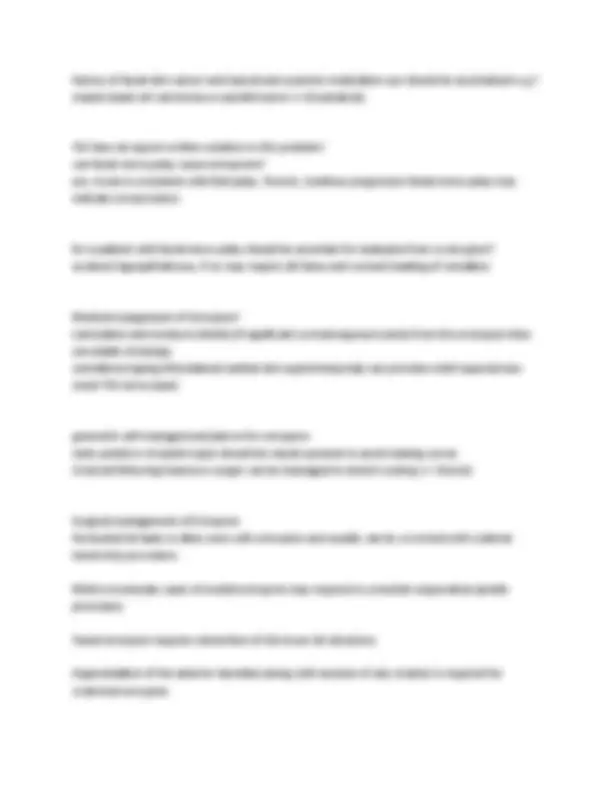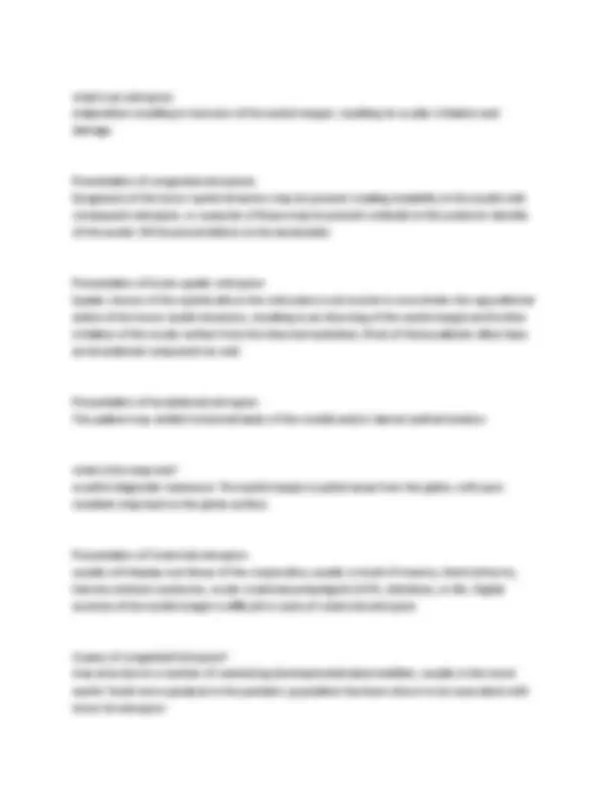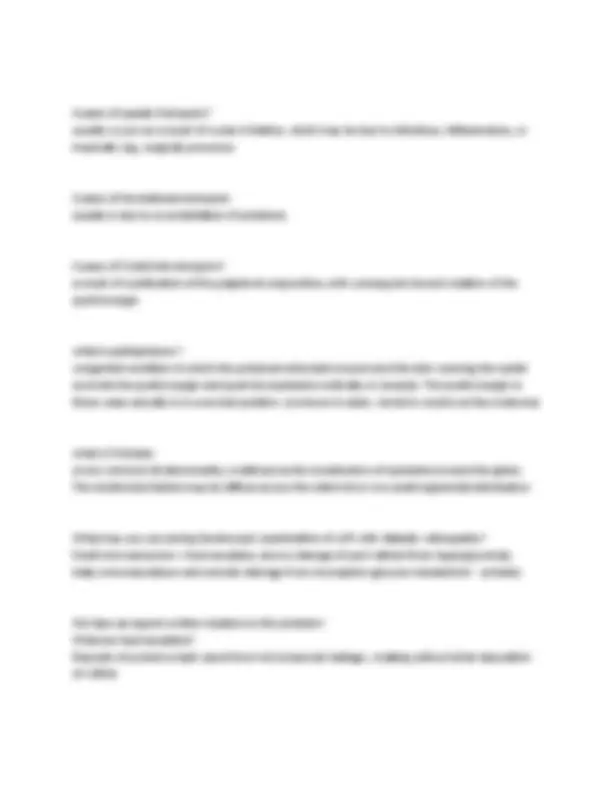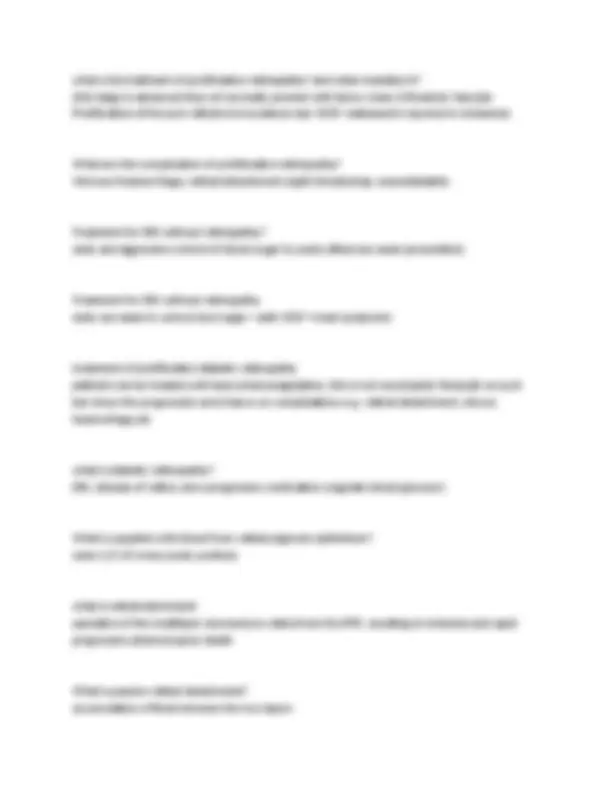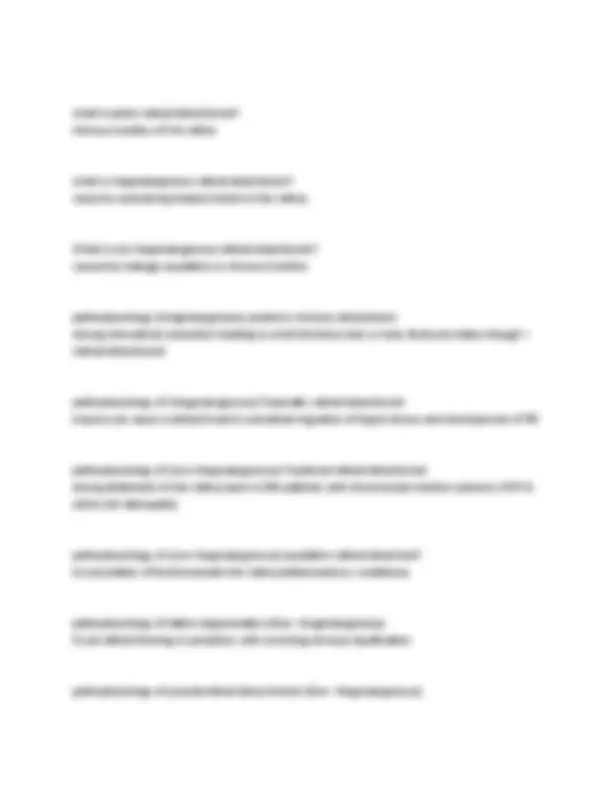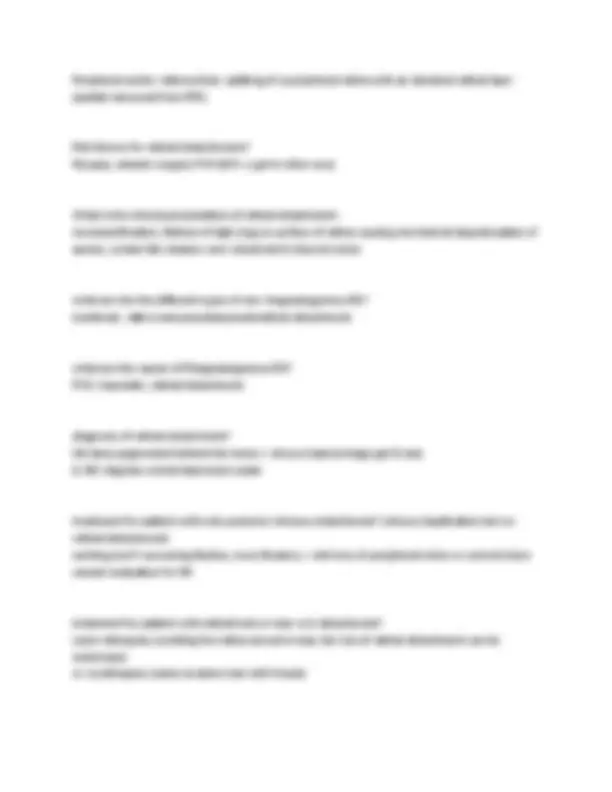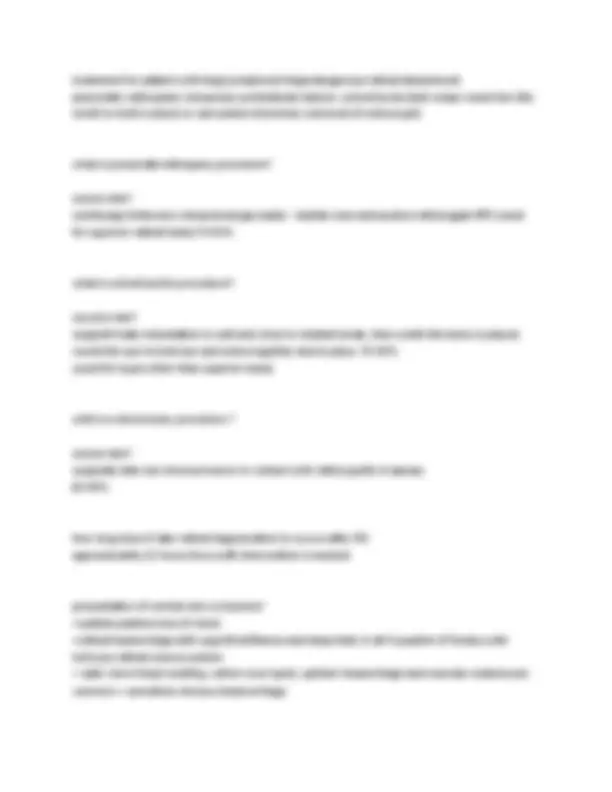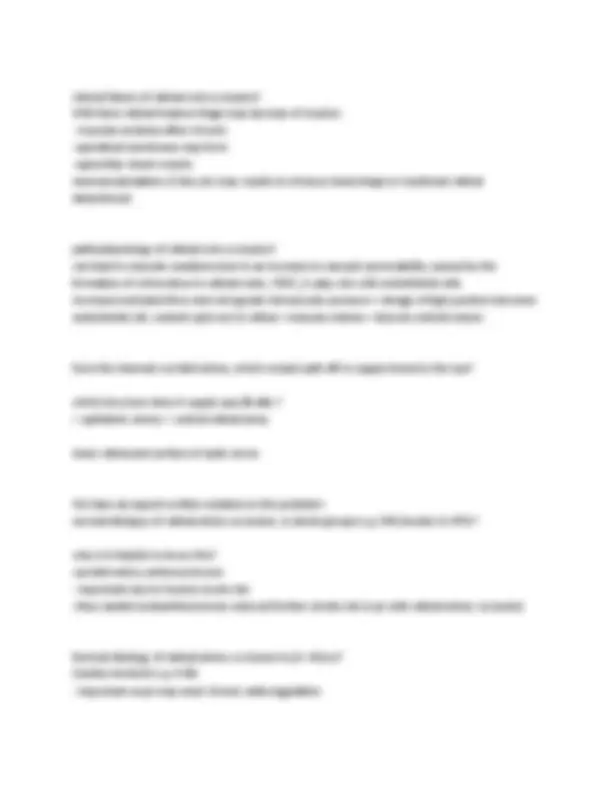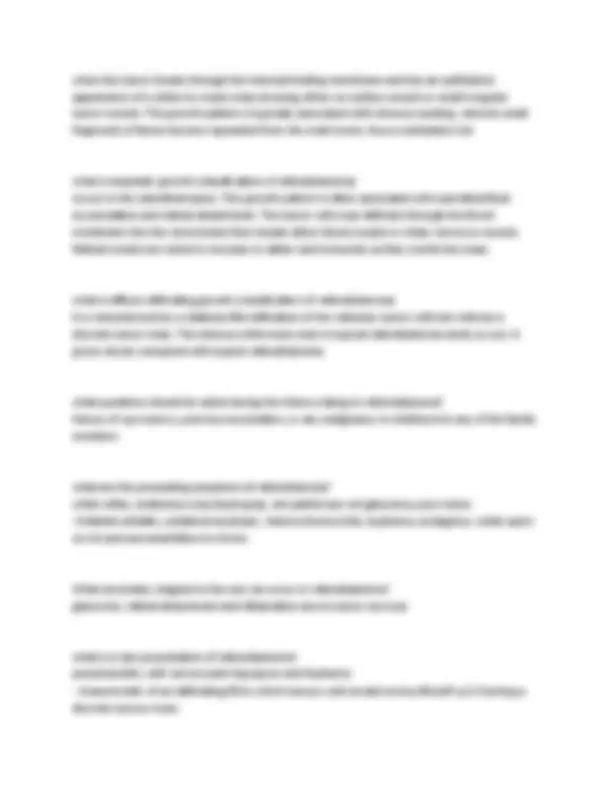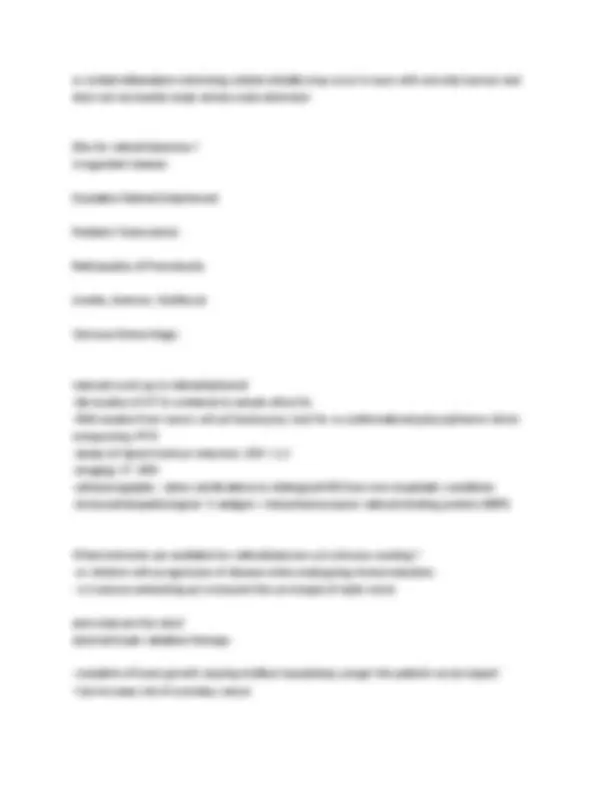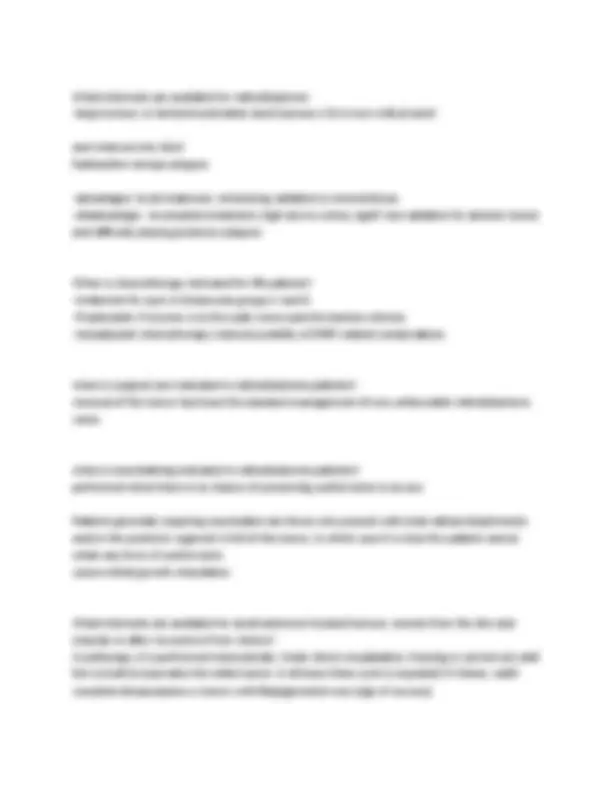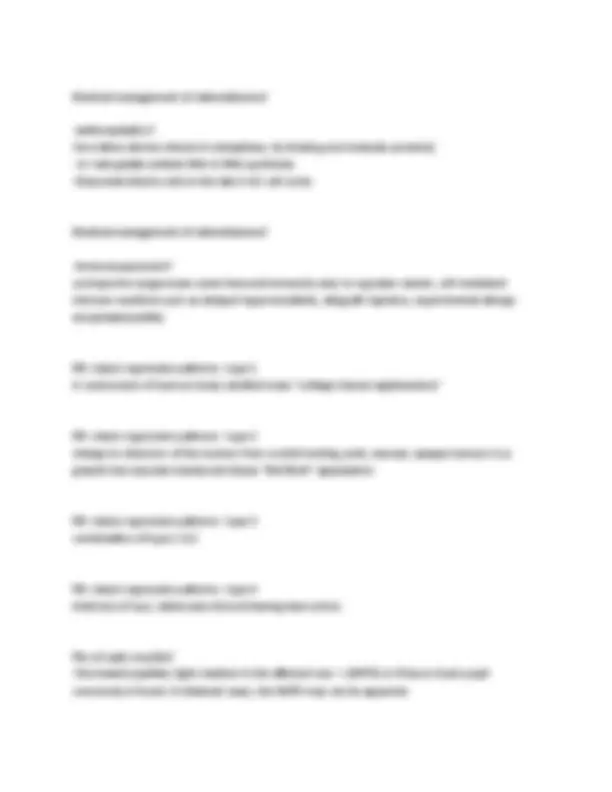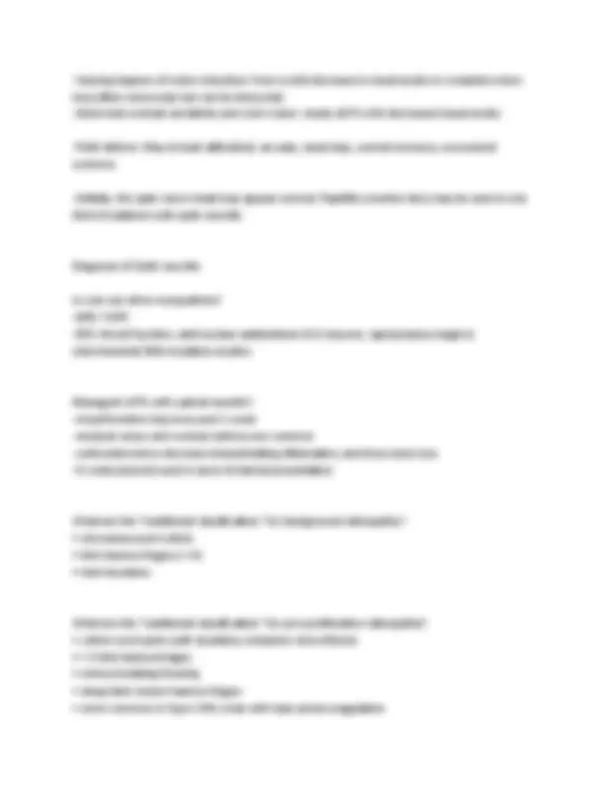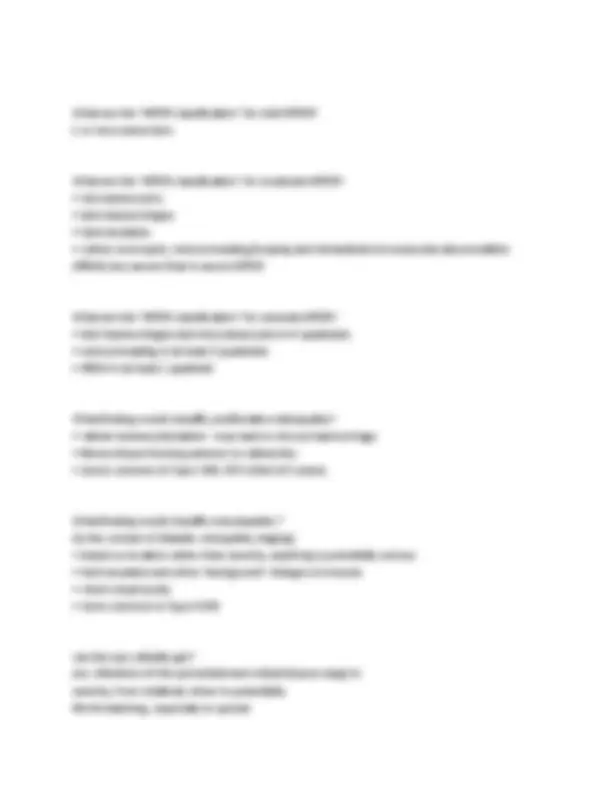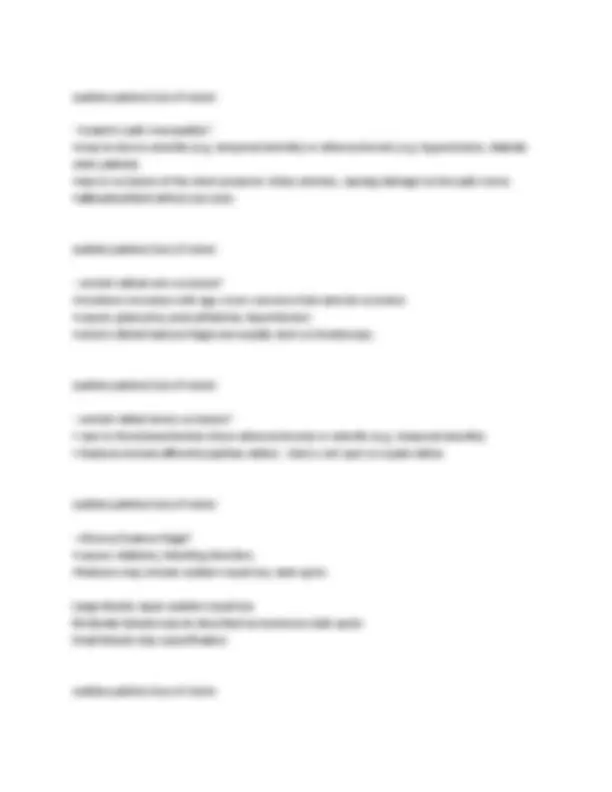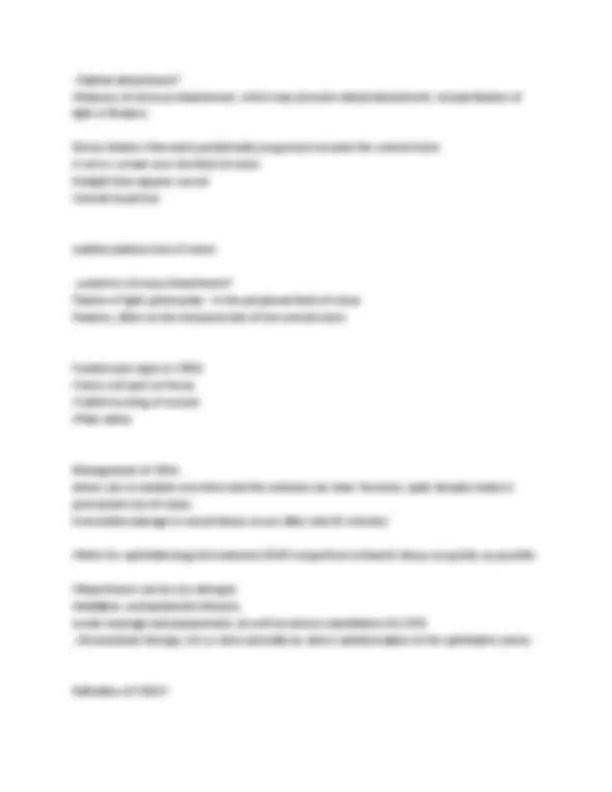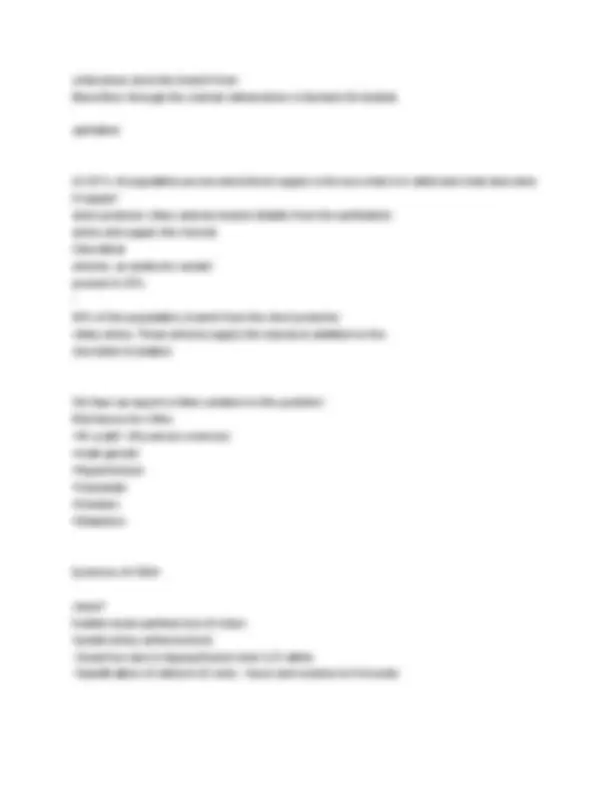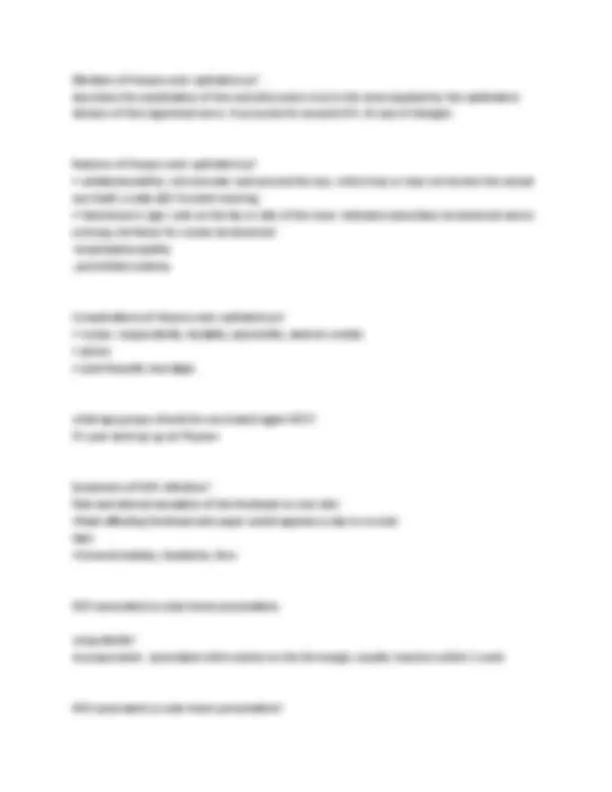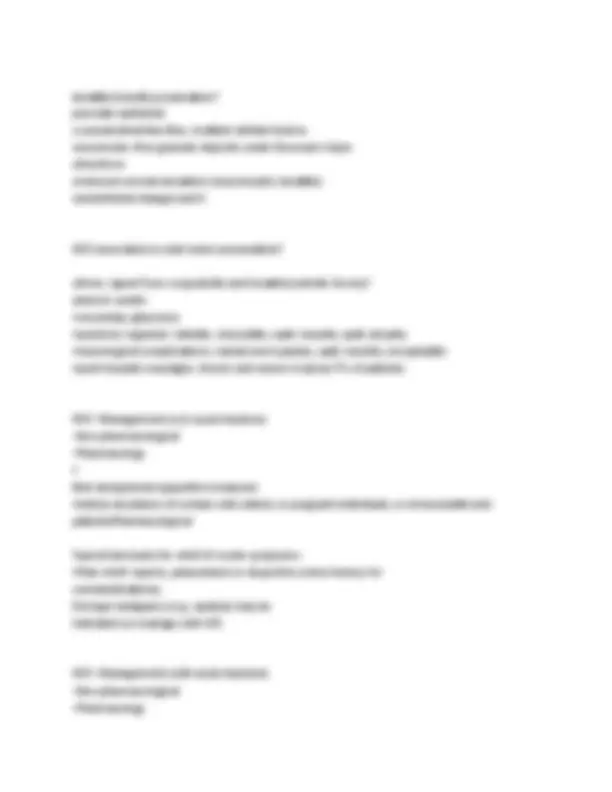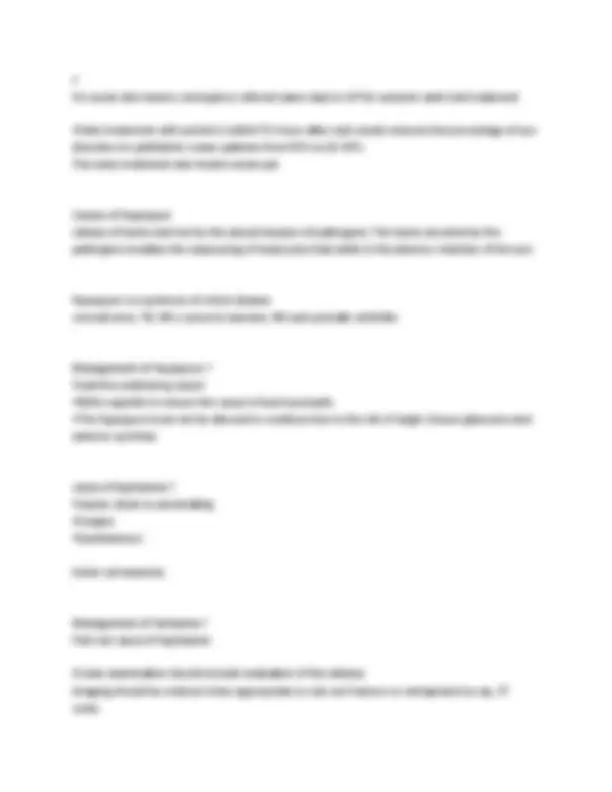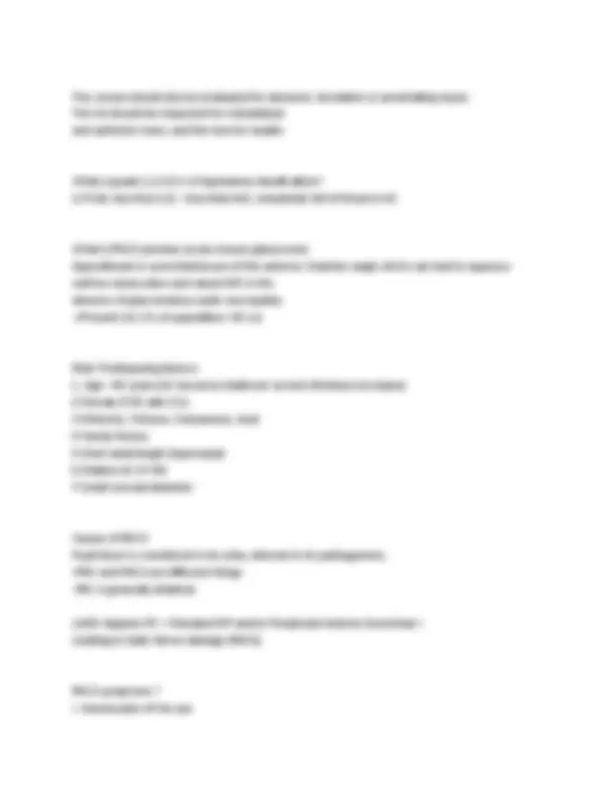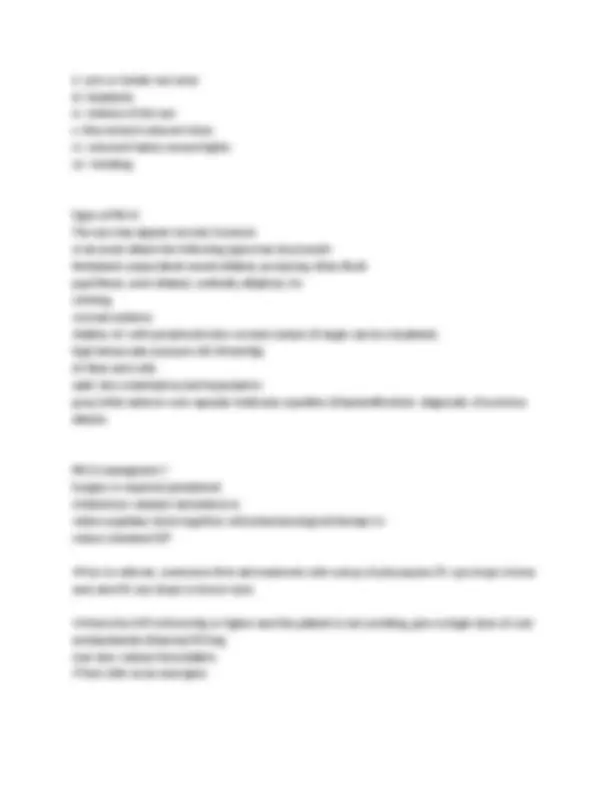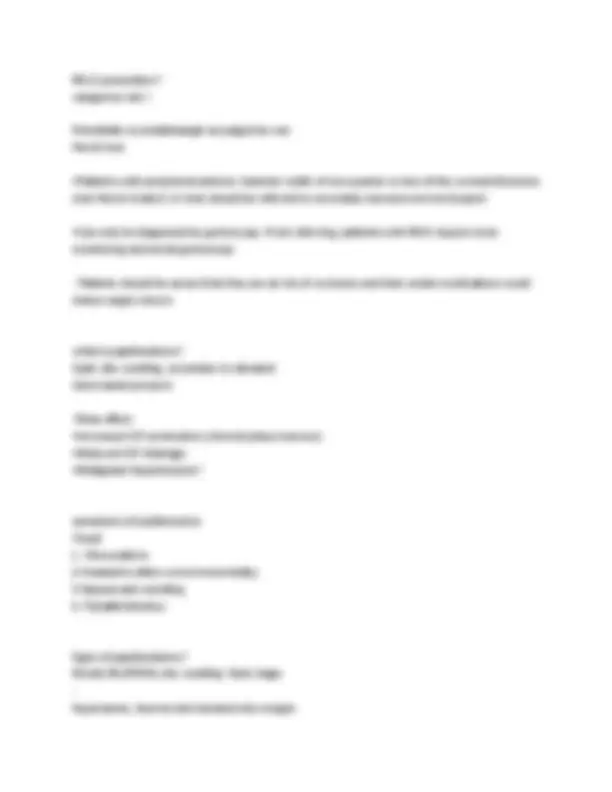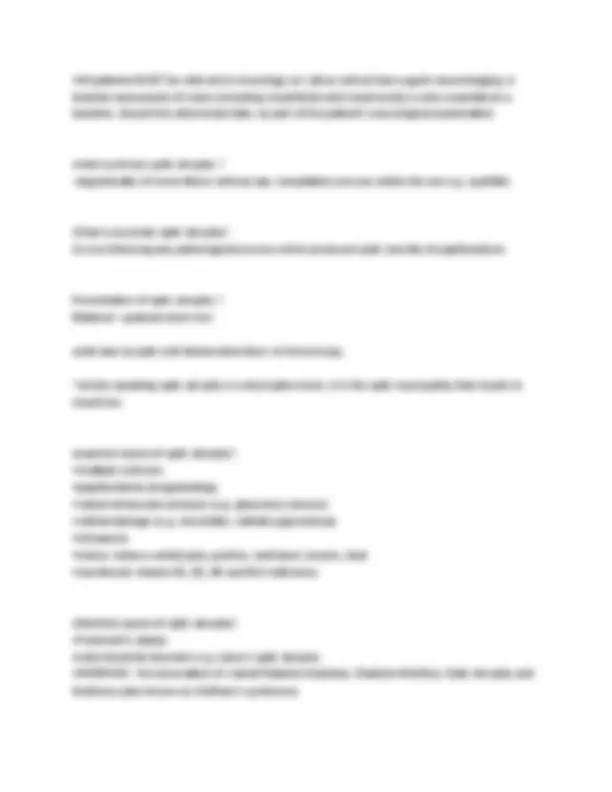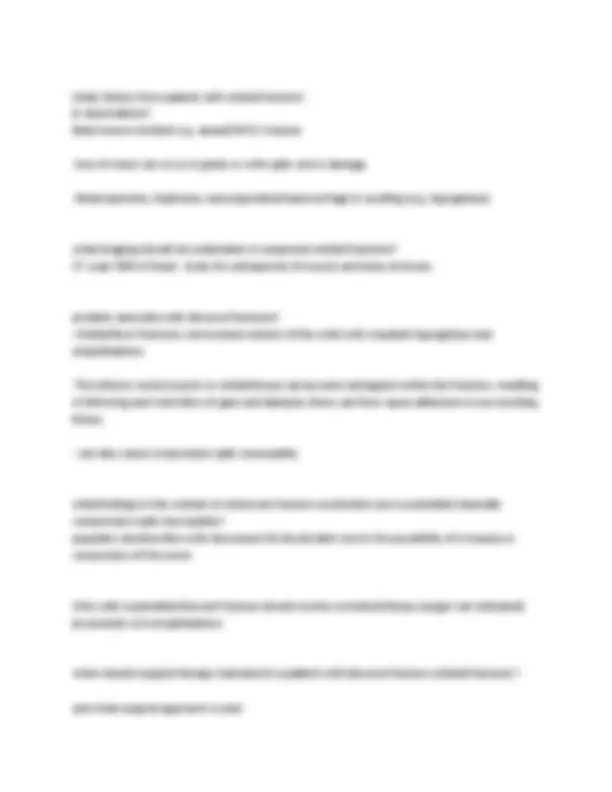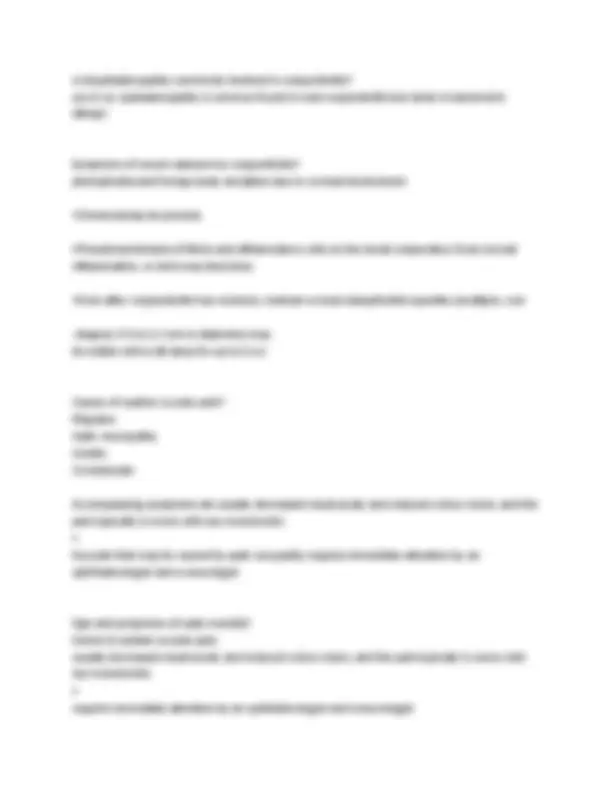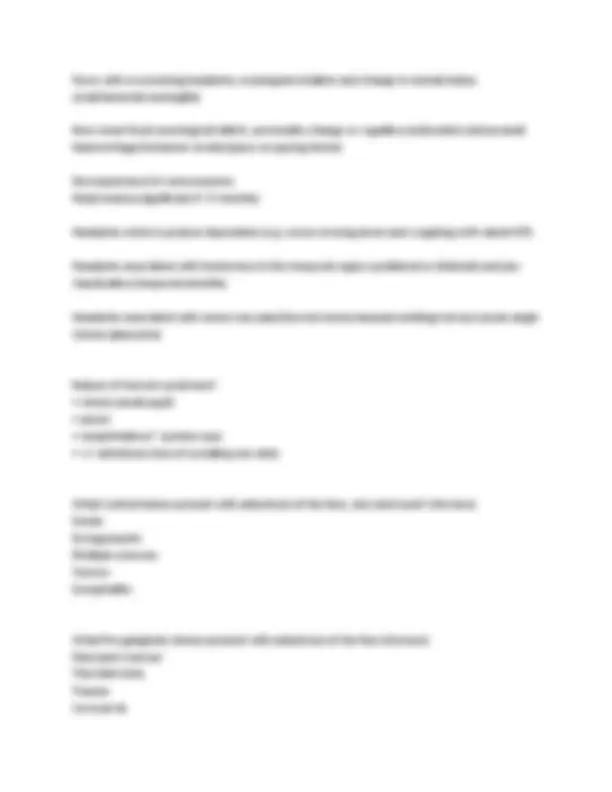Download VMT Surgical Nursing Final Exam LATEST 2024.2025 100% ACCURATE GRADED A+ and more Exams Nursing in PDF only on Docsity!
VMT Surgical Nursing Final Exam LATEST 2024.2025 100%
ACCURATE GRADED A+
What is hypermetropia? long sitedness, whereby light ray convergence at a point after the retina, and therefore out of focus. Nearby objects apphear blurry while distant objects are clearer what is myopia? near/short sightedness, close is clear, far is blurry
- usual starts in puberty and gets worse untill eye is fully grown. also in very young children. conditions associated with myopia? squint- childhood eyes point in diff. directions. lazy eyechildhood, one eye. doesnt develop properly glaucoma - IOC pressure. cataracts - develpoment of cloudy atches inside lense. Retinal detachment - wherby retina pulls awat from the blood vessel that nourish it What is astigmatism? Failure to converge image at one point on the fovea (likea refraction rather than focusing) Causes of astigmatism?
- Hereditary - corneal or lenticular
- Injuries to the cornea, such as infection that scars the cornea keratoconus & kertoglobus - causes bulgin, thinner and shape change. Some conditions of the eyelid others that affect cornea or lense
What is presbyopia? gradual loss of your eyes' ability to focus on nearby objects. It's a natural part of aging 40-65yrs Aetiology of bacterial conjunctivitis? S.Aureus, Sterp. Pneumo or H.flu also STIs chlamydia trachromatis, N.gonnorheae what is opthalmia neonatorum? chlamydia or gonorrheae infection from infected birth canal affecting 20-40% What is Episcleritis? Inflamationof localiased superficial episclera vascular network, most commonly diffuse (moderate to sever inflam @1-3 month intervals)
- Nodular/focal episcleritis (can often present with associated systemic disease) What are the classification of Allergic conjunctivitis? type 1 hypersensitivity - seasonal (SAC) perrenial - chronic (PAC) Atopic - relates to eczema and athsma gaint pappilary (GPC) Limbal and tarsal kertaoconjuctivitis (VKC) What is gaint pappilary Allergica conjunctivitis inner lining of the eyelid swells and develops small bumps. Known as papillae, these bumps tend to form after chronic irritation what can cause a corneal abbration? Direct trauma Foreign body between eyelid and conjunctiva Heat by contact UV radiation (Arc Eye)
Blurred vision and floaters Absence of symptoms of anterior uveitis (ie, pain, redness, and photophobia) All parts of the posterior chamber may be affected, including the retina, choroid and optic nerve. It can be caused by bacterial, fungal, viral and parasitic infections. What are the findings of posterior Uveitis upon opthalmoscopy? posterior uveitis Showing candle wax drippings (white areas) Anterior uventis is linked to which non infectious diseases?
- Ankyolising spondilitis,
- behcet syndrom (ulcers eye,mouth & genitals),
- IBS,
- Juvenile arthritis, sarcoidosis (Granulomatous disease),
- seronegative arthropathy Anterior uventis is linked to which infectious diseases? HSV, SYphilis, TB & varicella zoster Intermediate uventis (Cillary body to retina) is linked to which non-infectious disease? Lymphoma, MS and sarcoidosis Posterior uventis (Retina, retinavvessels) and Panuverntis (iris, cilliary body and choroid layer) - is linked which non-infectious diseases? Behcets sydrome, lymphoma, sarcoidosis Posterior uventis (Retina, retinavvessels) and Panuverntis (iris, cilliary body and choroid layer) - is linked which infectious diseases? CMV, endogenous encephalitis, syphalis. TB and varicella zoster Toxicaris & toxoplasmosis
Workup for suspected uveitis? CBC, ESR, Antinuclear antibody (ANA), Rapid plasma reagin (RPR) Venereal disease research laboratory (VDRL) Lyme titer HLA testing for ankylosing spondylarthroses Chest radiography (to assess for sarcoidosis or tuberculosis) Urinalysis (for red blood cells or casts) Infectious workup (eg, HIV, toxoplasmosis), depending on the presentation What is a HYPOpyon It is a leukocytic exudate, seen in the anterior chamber, usually accompanied by redness of the conjunctiva and the underlying episclera
- often co-inside with behcets disease, endophthalmitis, panuveitis/panopthalmitis & Averse drug reactions what are anterior synchiae? Peripheral anterior synechiae (PAS) Adhesions between the iris and trabecular meshwork PAS result from prolonged appositional contact between the iris and trabecular meshwork PAS may reduce outflow of aqueous humor May lead to raised intraocular pressure What are floaters? Spots, threads, or fragments of cobwebs, which float slowly before the observer's eyes commony collagen breaking down to fibrils, retinal tears and tear film debris of conjuctival surface what are cateracts and how will a pateint present? Gradual thickening of the lens. Hx of progressive residual deteriation and disturbance in night & near vision
Central scotoma Cecocentral scotoma Papillitis (swollen disc): Found in one third of patients with optic neuritis Symptoms of optical neuritis?
- Preceding viral illness Rapidly impairmed vision in 1 eye or, less commonly, both eyes:
- Dyschromatopsia (change in color perception) in the affected eye: sometimes more prominent than decreased vision. Retro-orbital or ocular pain:
- vision changes & usually exacerbated by eye movement; the pain may precede vision loss.
- Uhthoff phenomenon = vision loss is exacerbated by heat or exercise
- Pulfrich phenomenon, in which objects moving in a straight line appear to have a curved trajectory: Presumably caused by asymmetrical conduction between the optic nerves Symptoms of retinitis pigmentosa? Common symptoms include difficulty seeing at night and a loss of side (peripheral) vision What is retinitis pigmentosa? rare, genetic disorders that involve a breakdown and loss of cells in the retina. Mutations in one of more than 50 genes is involved. There is no cure for retinitis pigmentosa. what is primary open angle glaucoma most common type, which tends to develop slowly over many years Symtoms of glaucoma? intense eye pain a red eye a headache tenderness around the eyes seeing rings (halo) around lights
blurred vision What is DARC (detection of apoptosing retinal cells) Real-time imaging of single neuronal cell apoptosis in patients with glaucoma Annexin 5 labelled with fluorescent dye DY- 776 (phosphatidylserine exposed on apoptotic cell membranes) what is secondary glaucoma? caused by an underlying eye condition, such as uveitis (inflammation of the eye) what is childhood glaucoma? a rare type that occurs in very young children, caused by an abnormality of the eye Risk factor for glaucoma? Age - glaucoma becomes more likely as you get older and the most common type affects around 1 in 10 people over 75 Ethnicity - people of African, Caribbean or Asian origin are at a higher risk of glaucoma Family history - you're more likely to develop glaucoma if you have a parent or sibling with the condition High Myopia prostoglandins are most useful in which type of glaucoma Effective at reducing intraocular pressure in pts with open-angle glaucoma what are Carbonic Anhydrase Inhibitors and how do they treat glaucoma? reduce eye pressure by decreasing the production of intraocular fluid. The pill form (Acetazolamide)is an alternative for people whose glaucoma is not controlled by medication eye drops. Medical managemnet of glaucoma?
Smoking (past or present) Low macular pigment Having light skin or light eyes Exposure to the sun Poor diet Being overweight Being a woman, as they normally develop AMD at an earlier age than men Symtoms of retinal detachment? Photopsia (common initially) Visual field defect (developing over time; may help localize detachment) Floaters & flashes Reduced VA distortion curtain field effect what is macular degeneration? how does this impact daily life? when cnetral vision is disrupted, directly what is infront of you. (peripheral vision is kept!) vision becomes increasingly blurred, which means: Reading becomes difficult Colours appear less vibrant Facial Recognition becomes difficult This sight loss usually happens gradually over time, although it can sometimes be rapid. what is Tractional retinal detachment? This results from adhesions between the vitreous gel/fibrovascular proliferation and the retina what is DRY AMD?
develops when the cells of the macula become damaged by a build-up of deposits called drusen. It's the most common and least serious type of AMD, accounting for around 9 out of 10 cases. Vision loss is gradual, occurring over many years. However, an estimated 1 in 10 people with dry AMD go on to develop wet AMD. What is wet AMD? (macular haemorrhages from abnoral leaky vasculature)
- develops when abnormal blood vessels form underneath the macula and damage its cells. Wet AMD is more serious than dry AMD. Without treatment, vision can deteriorate within days. What is Pre-proliferative retinopathy?
- more severe and widespread changes affect the blood vessels, including more significant bleeding into the eye what is Rhegmatogenous retinal detachment? (the most common type) - This results when a hole, tear, or break in the neuronal layer allows fluid from the vitreous to seep between and separate sensory and RPE layers What is Anti- VEGF treatment? Antibody against VEGF During WET AMD, neovasculisation produces molecules of VEGF that enourages further vascular leak and neovascularisation = further damage what is Exudative retinal detachment? serous) retinal detachment - This results from exudation of material into the subretinal space from retinal vessels (as in hypertension, central retinal venous occlusion, vasculitis, or papilledema What is diabetic retinopathy
produces a superficial and painful keratitis what is the onset and symptoms of ARC EYE? (bilateral ) corneal redness pain intense bilateral lacrimation blepharospasm photophobia blurred vision / signs of reduced visual acuity sensation of a foreign body in the eye. (3-8 hrs after) what are the common signs and symptoms of blephritis itching, irritation, burning, discomfort Foreign body sensation Crusting around the eye lashes Lid thickening Loss of lashes Abnormal thickening of meibomian secretions (oil capping) Frothy tear film. Both eyes are usually How do symptoms present in blephritis?
(bi-laterally, intermittent & relapsing over long periods, worse in morning) Causes/classification of blephritis? Staphylococcal blepharitis Seborrhoeic blepharitis Meibomian blepharitis - Meibomian gland dysfunction Self managment advice for a patient with Blephritis? improves in 2-3 weeks:
- avoid eye make up Apply warm compresses to closed eyelids for 5-10 m inutes.
- For posterior blepharitis , massage the eyelid to express Meibomian glands.
- Clean the eyelid — wet a cloth or cotton bud with cleanser (e.g. a sodium bicarbonate )and rub along the lid margins.
- Many optometrists sell cleaner e.g. blephasol medical mangement of Consider topical antibiotics (chloramphenicol or fusidic acid) or oral antibiotics (tetracyclines) if there are clear signs of staphylococcal infection or Meibomian gland dysfunction, respectively. NB Antibiotics should usually be reserved for second-line use, when eyelid hygiene alone has proved ineffective Blepharitis frequently causes dry eye: prescribe a rtificial tears or ocular lubricant to relieve symptoms When should you refer blephritis Pt?
Rapid and/or painful changes in vision are suspicious for other eye diseases and should be referred for specialist opinion.
- patients with visual acuity of 6/12 or worse in cataract affects eye after correction (glasses) What is the surgical managment of Cataracts removing the cloudy lens and replacing it with an intraocular implant under local anaesthetic. Non surgical management of Cataracts? Reducing glare by wearing a hat or sunglasses in bright light correcting refractive problems with spectacles or contact lenses increasing light levels when working or reading to improve contrast referral for generic management of visual impairment (which may involve social services and provision of accessibility aids) Benfits of cataract surgery mproved visual acuity. 85-90% of people will have 6/12 best corrected vision (This meets the driving requirements in the UK). However, reading glasses are usually needed after cataract surgery, and some people may require glasses for distance vision who did not previously require them
- Improved clarity of vision
- Improved colour vision. How will a Pt present with conjunctivits? Red,eyes, normal, visual aquity and normal cornea What is the initial treatment for irritant conjunctivitis? Remove/neutralise irritant if possible e.g. a displaced contact lens; foreign
body; eye lashes rubbing against the surface of the eye; a chemical splashing, etc Presentation of Allergic conjuctivits?
- Bilateral itchy eyes
- Oedema - 'cobblestone' appearance on upper eyelids when inflammation is chronic
- Patient also suffers from eczema, allergic rhinitis, or asthma. giant papillary conjunctivitis 1-5% with soft C.lenses 1% of people with hard C.lense symtoms and presentation of bacterial Conjunctivitis? Sore, swollen sticky/matted eye on waking + photophobic
- can be uni/bilateral
- acute- yellow purulent discharge
- mild- mucopurulent (sticky yellow)
- pappilae
- palpable pre-auricular nodes
- timing- acute or chronic symtoms and presentation of viral Conjunctivitis?
- Feels unwell.
- Watery, sticky, gritty, sometimes subconjunctival haemorrhage.
- (Bilateral)
- H/O upper respiratory tract infection
- serous (watery liquid)
- follicle & papillae involved
- pres auricular node is palpable and tender
- Acute onset
A positive bacterial culture — prescribe a topical ocular antibiotic directed by sensitivity results if they are still symptomatic. Positive chlamydial cultures — refer to GUM for testing of sexual contacts and systemic treatment. A negative bacterial and chlamydial culture — consider repeating the test if symptoms persist for longer than 3 weeks
review in 1/52 if no better Drugs & Magment of suspected viral Conjunctivits? Reassurance
- gel tears or viscotears or nothing
- can give topical antibiotic cover for 1/52 to prevent secondary bacterial infection
- if Pt wears contact lenses refer to optometrist to check cornea When to refer in Conjunctivitis? If reduced vision or not responding in 2nd care, particularly severe atopic.
- adults with Chylamidial inf.
- penetrating cause of irritant conjunctivitis
- neonatal conjunctivitis - refer to 2ns care and check for chylamidia and & gonnococal causes what can cause Corneal abbrations/Ulcers? grit, finger nail, foreign body or by a contact lens, injuring the epithelial tissue. Wearing contact lenses incorrectly can also cause injury (e.g. if not clean; if dirt/dust becomes trapped behind a lens; if do not fit properly or are worn for excessively long periods of time). Symtoms of corneal graft? How should you screen it?
- Severe eye pain
eye redness photophobia increased tears blurred / distorted vision squinting caused by eye muscle spasm sensation of foreign body in the eye, even if it has been removed. (with flouresin stain) Managment of corneal abrations/ulcers?
- Antibiotic ointment chloramphenicol (QTD for 1/52 )
- oral analgesics
- lubricants at night:
- ifcorneal erosion occ Lacri-Lube used at night every night for 3 months will resolve 80% and will also help prevent recurrence of erosion Refer corneal abration/ulcer if? ain does not resolve after use of antibiotic ointment Patient continues to experience blurred vision or a reduction in visual acuity Patient continues to experience considerable pain, despite analgesics Injury/abrasion penetrates beyond the Bowman's membrane into the corneal stroma Symptoms of recurrent erosion persist despite using regular ointment at night. What are the symptoms of developmental glaucoma? having large eyes (pressure causes eye to expand)
- photophobia

